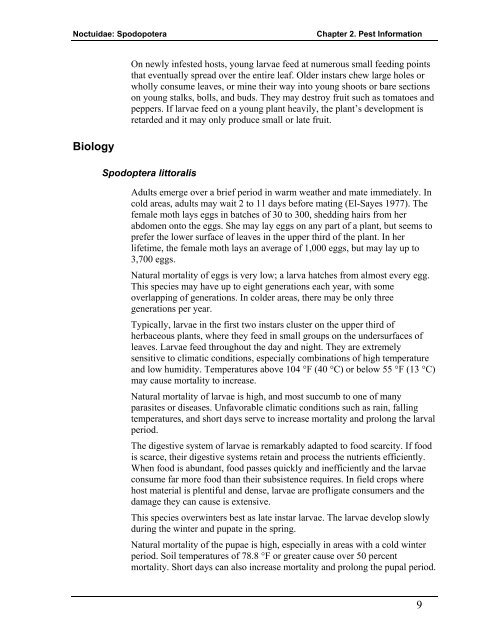New Pest Response Guidelines - Phytosanitary Resources
New Pest Response Guidelines - Phytosanitary Resources
New Pest Response Guidelines - Phytosanitary Resources
Create successful ePaper yourself
Turn your PDF publications into a flip-book with our unique Google optimized e-Paper software.
Noctuidae: Spodopotera<br />
Chapter 2. <strong>Pest</strong> Information<br />
On newly infested hosts, young larvae feed at numerous small feeding points<br />
that eventually spread over the entire leaf. Older instars chew large holes or<br />
wholly consume leaves, or mine their way into young shoots or bare sections<br />
on young stalks, bolls, and buds. They may destroy fruit such as tomatoes and<br />
peppers. If larvae feed on a young plant heavily, the plant’s development is<br />
retarded and it may only produce small or late fruit.<br />
Biology<br />
Spodoptera littoralis<br />
Adults emerge over a brief period in warm weather and mate immediately. In<br />
cold areas, adults may wait 2 to 11 days before mating (El-Sayes 1977). The<br />
female moth lays eggs in batches of 30 to 300, shedding hairs from her<br />
abdomen onto the eggs. She may lay eggs on any part of a plant, but seems to<br />
prefer the lower surface of leaves in the upper third of the plant. In her<br />
lifetime, the female moth lays an average of 1,000 eggs, but may lay up to<br />
3,700 eggs.<br />
Natural mortality of eggs is very low; a larva hatches from almost every egg.<br />
This species may have up to eight generations each year, with some<br />
overlapping of generations. In colder areas, there may be only three<br />
generations per year.<br />
Typically, larvae in the first two instars cluster on the upper third of<br />
herbaceous plants, where they feed in small groups on the undersurfaces of<br />
leaves. Larvae feed throughout the day and night. They are extremely<br />
sensitive to climatic conditions, especially combinations of high temperature<br />
and low humidity. Temperatures above 104 °F (40 °C) or below 55 °F (13 °C)<br />
may cause mortality to increase.<br />
Natural mortality of larvae is high, and most succumb to one of many<br />
parasites or diseases. Unfavorable climatic conditions such as rain, falling<br />
temperatures, and short days serve to increase mortality and prolong the larval<br />
period.<br />
The digestive system of larvae is remarkably adapted to food scarcity. If food<br />
is scarce, their digestive systems retain and process the nutrients efficiently.<br />
When food is abundant, food passes quickly and inefficiently and the larvae<br />
consume far more food than their subsistence requires. In field crops where<br />
host material is plentiful and dense, larvae are profligate consumers and the<br />
damage they can cause is extensive.<br />
This species overwinters best as late instar larvae. The larvae develop slowly<br />
during the winter and pupate in the spring.<br />
Natural mortality of the pupae is high, especially in areas with a cold winter<br />
period. Soil temperatures of 78.8 °F or greater cause over 50 percent<br />
mortality. Short days can also increase mortality and prolong the pupal period.<br />
9













